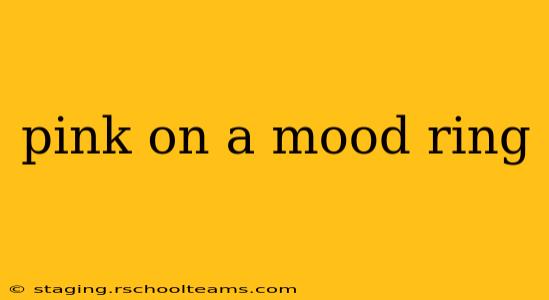Mood rings have captivated people for decades with their promise of revealing hidden emotions through color changes. While the science behind them is dubious, their enduring popularity speaks to our fascination with self-expression and nonverbal communication. Let's delve into the meaning of pink on a mood ring, explore the technology (or lack thereof) behind these intriguing pieces of jewelry, and address some frequently asked questions.
What Does Pink Mean on a Mood Ring?
Generally, pink on a mood ring is associated with excitement, happiness, and contentment. It suggests a positive emotional state, representing feelings of joy, optimism, and overall well-being. However, the exact shade of pink and its interpretation can vary slightly depending on the specific ring and its accompanying chart. Some might associate darker pinks with more intense emotions, while lighter pinks indicate a gentler, more relaxed feeling.
It's crucial to remember that these interpretations are subjective and based on the manufacturer's color chart. There's no universally agreed-upon meaning for each color.
How Accurate Are Mood Rings?
This is the million-dollar question! The truth is, mood rings aren't scientifically accurate. They don't actually detect emotions. Instead, they rely on thermochromic liquid crystals embedded within the stone. These crystals change color in response to changes in skin temperature, not emotional states.
Factors influencing your skin temperature include:
- Ambient temperature: A hot room will likely result in a warmer ring, potentially changing the color.
- Physical activity: Exercise increases blood flow, raising skin temperature.
- Stress and anxiety (indirectly): While not directly measuring emotions, stress can affect blood flow and subsequently skin temperature. This indirect relationship is often cited as the reason behind the seeming accuracy of mood rings, but it's far from a direct measurement of emotional state.
- Health conditions: Certain health conditions can impact skin temperature and, consequently, the color displayed on the ring.
Do Mood Rings Reflect Actual Emotions?
No, mood rings do not directly reflect actual emotions. The color changes are a result of fluctuating body temperature, which is influenced by a variety of factors, only some of which are related to emotions. While a change in color might coincide with a change in mood, it's not a reliable indicator. The connection is largely coincidental and based on correlation, not causation.
Are Mood Rings a Real Way to Tell Your Mood?
No, mood rings are not a reliable way to tell your mood. As explained above, they respond to temperature changes, not emotions. They can be fun and fashionable accessories, but they shouldn't be taken as a scientific or accurate representation of your emotional state.
Why Do People Still Wear Mood Rings?
Despite their lack of scientific accuracy, mood rings continue to be popular for several reasons:
- Fashion accessory: They are stylish and fun pieces of jewelry.
- Conversation starter: They often spark interesting conversations and discussions.
- Self-expression: They can be a playful way to express oneself, even if the color changes aren't directly linked to emotions.
- Nostalgia: For many, they evoke feelings of nostalgia and childhood memories.
Conclusion
While a pink mood ring might suggest feelings of happiness and contentment, it's important to remember that this is based on a subjective interpretation of temperature-induced color changes. These rings are more of a fun fashion statement than a reliable emotional indicator. Enjoy them for their aesthetic appeal and conversation-starting potential, but don't rely on them for accurate emotional readings!
